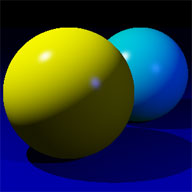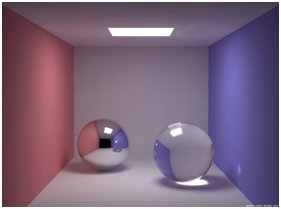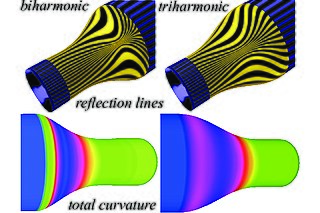This article needs additional citations for verification .(December 2009) |

Specularity is the visual appearance of specular reflections.
This article needs additional citations for verification .(December 2009) |

Specularity is the visual appearance of specular reflections.
In computer graphics, it means the quantity used in three-dimensional (3D) rendering which represents the amount of reflectivity a surface has. It is a key component in determining the brightness of specular highlights, along with shininess to determine the size of the highlights.
It is frequently used in real-time computer graphics and ray tracing, where the mirror-like specular reflection of light from other surfaces is often ignored (due to the more intensive computations required to calculate it), and the specular reflection of light directly from point light sources is modeled as specular highlights.
A materials system may allow specularity to vary across a surface, controlled by additional layers of texture maps.
Early shaders included a parameter called "Specularity". CG Artists, confused by this term discovered by experimentation that the manipulation of this parameter would cause a reflected highlight from a light source to appear and disappear and therefore misinterpreted "specularity" to mean "light highlights". In fact "Specular" is defined in optics as Optics. (of reflected light) directed, as from a smooth, polished surface (opposed to diffuse ). A specular surface is a highly smooth surface. When the surface is very smooth, the reflected highlight is easy to see. As the surface becomes rougher, the reflected highlights gets broader and dimmer. This is a more "diffused" reflection. [1] [2]
In the context of seismic migration, specularity is defined as the cosine of the angle made by the surface normal vector and the angle bisector of the angle defined by the directions of the incident and diffracted rays. [3] For a purely specular seismic event the value of specularity should be equal to unity, as the angle between the surface normal vector and the angle bisector should be zero, according to Snell's Law. For a diffractive seismic event, the specularity can be sub-unitary. During the seismic migration, one can filter each seismic event according to the value of specularity, in order to enhance the contribution of diffractions in the seismic image. Alternatively, the events can be separated in different sub-images according to the value of specularity to produce a specularity gather. [4]

Rendering or image synthesis is the process of generating a photorealistic or non-photorealistic image from a 2D or 3D model by means of a computer program. The resulting image is referred to as the render. Multiple models can be defined in a scene file containing objects in a strictly defined language or data structure. The scene file contains geometry, viewpoint, texture, lighting, and shading information describing the virtual scene. The data contained in the scene file is then passed to a rendering program to be processed and output to a digital image or raster graphics image file. The term "rendering" is analogous to the concept of an artist's impression of a scene. The term "rendering" is also used to describe the process of calculating effects in a video editing program to produce the final video output.

Optics is the branch of physics that studies the behaviour and properties of light, including its interactions with matter and the construction of instruments that use or detect it. Optics usually describes the behaviour of visible, ultraviolet, and infrared light. Because light is an electromagnetic wave, other forms of electromagnetic radiation such as X-rays, microwaves, and radio waves exhibit similar properties.

The reflectance of the surface of a material is its effectiveness in reflecting radiant energy. It is the fraction of incident electromagnetic power that is reflected at the boundary. Reflectance is a component of the response of the electronic structure of the material to the electromagnetic field of light, and is in general a function of the frequency, or wavelength, of the light, its polarization, and the angle of incidence. The dependence of reflectance on the wavelength is called a reflectance spectrum or spectral reflectance curve.
The Phong reflection model is an empirical model of the local illumination of points on a surface designed by the computer graphics researcher Bui Tuong Phong. In 3D computer graphics, it is sometimes referred to as "Phong shading", particularly if the model is used with the interpolation method of the same name and in the context of pixel shaders or other places where a lighting calculation can be referred to as “shading”.

In 3D computer graphics, Phong shading, Phong interpolation, or normal-vector interpolation shading is an interpolation technique for surface shading invented by computer graphics pioneer Bui Tuong Phong. Phong shading interpolates surface normals across rasterized polygons and computes pixel colors based on the interpolated normals and a reflection model. Phong shading may also refer to the specific combination of Phong interpolation and the Phong reflection model.

Shading refers to the depiction of depth perception in 3D models or illustrations by varying the level of darkness. Shading tries to approximate local behavior of light on the object's surface and is not to be confused with techniques of adding shadows, such as shadow mapping or shadow volumes, which fall under global behavior of light.

Reflection is the change in direction of a wavefront at an interface between two different media so that the wavefront returns into the medium from which it originated. Common examples include the reflection of light, sound and water waves. The law of reflection says that for specular reflection the angle at which the wave is incident on the surface equals the angle at which it is reflected.

Specular reflection, or regular reflection, is the mirror-like reflection of waves, such as light, from a surface.

Lambertian reflectance is the property that defines an ideal "matte" or diffusely reflecting surface. The apparent brightness of a Lambertian surface to an observer is the same regardless of the observer's angle of view. More technically, the surface's luminance is isotropic, and the luminous intensity obeys Lambert's cosine law. Lambertian reflectance is named after Johann Heinrich Lambert, who introduced the concept of perfect diffusion in his 1760 book Photometria.

The bidirectional reflectance distribution function is a function of four real variables that defines how light is reflected at an opaque surface. It is employed in the optics of real-world light, in computer graphics algorithms, and in computer vision algorithms. The function takes an incoming light direction, , and outgoing direction, , and returns the ratio of reflected radiance exiting along to the irradiance incident on the surface from direction . Each direction is itself parameterized by azimuth angle and zenith angle , therefore the BRDF as a whole is a function of 4 variables. The BRDF has units sr−1, with steradians (sr) being a unit of solid angle.

A specular highlight is the bright spot of light that appears on shiny objects when illuminated. Specular highlights are important in 3D computer graphics, as they provide a strong visual cue for the shape of an object and its location with respect to light sources in the scene.

Gloss is an optical property which indicates how well a surface reflects light in a specular (mirror-like) direction. It is one of the important parameters that are used to describe the visual appearance of an object. The factors that affect gloss are the refractive index of the material, the angle of incident light and the surface topography.

In optics, a ray is an idealized geometrical model of light or other electromagnetic radiation, obtained by choosing a curve that is perpendicular to the wavefronts of the actual light, and that points in the direction of energy flow. Rays are used to model the propagation of light through an optical system, by dividing the real light field up into discrete rays that can be computationally propagated through the system by the techniques of ray tracing. This allows even very complex optical systems to be analyzed mathematically or simulated by computer. Ray tracing uses approximate solutions to Maxwell's equations that are valid as long as the light waves propagate through and around objects whose dimensions are much greater than the light's wavelength. Ray optics or geometrical optics does not describe phenomena such as diffraction, which require wave optics theory. Some wave phenomena such as interference can be modeled in limited circumstances by adding phase to the ray model.
The Blinn–Phong reflection model, also called the modified Phong reflection model, is a modification developed by Jim Blinn to the Phong reflection model.
Computer graphics lighting is the collection of techniques used to simulate light in computer graphics scenes. While lighting techniques offer flexibility in the level of detail and functionality available, they also operate at different levels of computational demand and complexity. Graphics artists can choose from a variety of light sources, models, shading techniques, and effects to suit the needs of each application.

A plane mirror is a mirror with a flat (planar) reflective surface. For light rays striking a plane mirror, the angle of reflection equals the angle of incidence. The angle of the incidence is the angle between the incident ray and the surface normal. Therefore, the angle of reflection is the angle between the reflected ray and the normal and a collimated beam of light does not spread out after reflection from a plane mirror, except for diffraction effects.

Photometric stereo is a technique in computer vision for estimating the surface normals of objects by observing that object under different lighting conditions. It is based on the fact that the amount of light reflected by a surface is dependent on the orientation of the surface in relation to the light source and the observer. By measuring the amount of light reflected into a camera, the space of possible surface orientations is limited. Given enough light sources from different angles, the surface orientation may be constrained to a single orientation or even overconstrained.

Engineers use reflection lines to judge a surface's quality. Reflection lines reveal surface flaws, particularly discontinuities in normals indicating that the surface is not . Reflection lines may be created and examined on physical surfaces or virtual surfaces with the help of computer graphics. For example, the shiny surface of an automobile body is illuminated with reflection lines by surrounding the car with parallel light sources. Virtually, a surface can be rendered with reflection lines by modulating the surfaces point-wise color according to a simple calculation involving the surface normal, viewing direction and a square wave environment map.
This is a glossary of terms relating to computer graphics.

Physically based rendering (PBR) is a computer graphics approach that seeks to render images in a way that models the flow of light in the real world. Many PBR pipelines aim to achieve photorealism. Feasible and quick approximations of the bidirectional reflectance distribution function and rendering equation are of mathematical importance in this field. Photogrammetry may be used to help discover and encode accurate optical properties of materials. Shaders may be used to implement PBR principles.